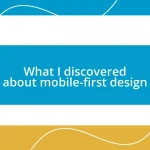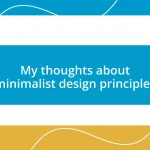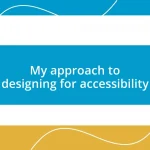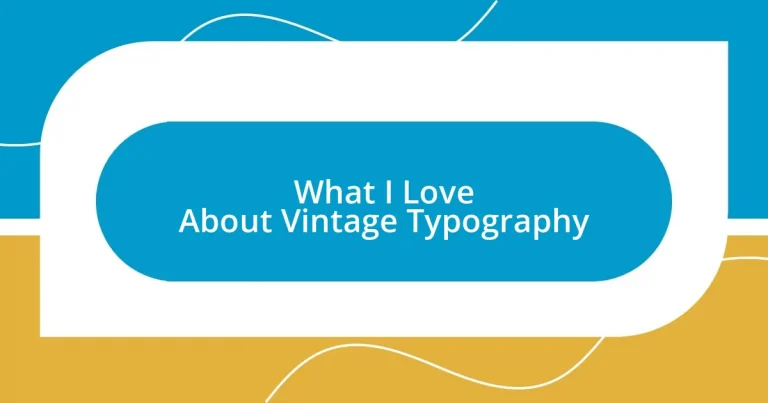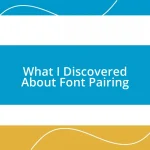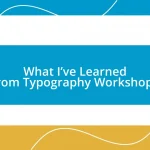Key takeaways:
- Vintage typography serves as a gateway to history, reflecting the design sensibilities and emotional tones of different eras.
- Key characteristics include serifs, ornamentation, handcrafted feel, varied stroke widths, and nostalgic styles that evoke specific sentiments.
- Using vintage typography can enhance emotional resonance, create unique project identities, and showcase craftsmanship, making design more relatable.
- Incorporating vintage typography effectively involves layering techniques, contrasting colors, and drawing inspiration from various resources like websites and books.
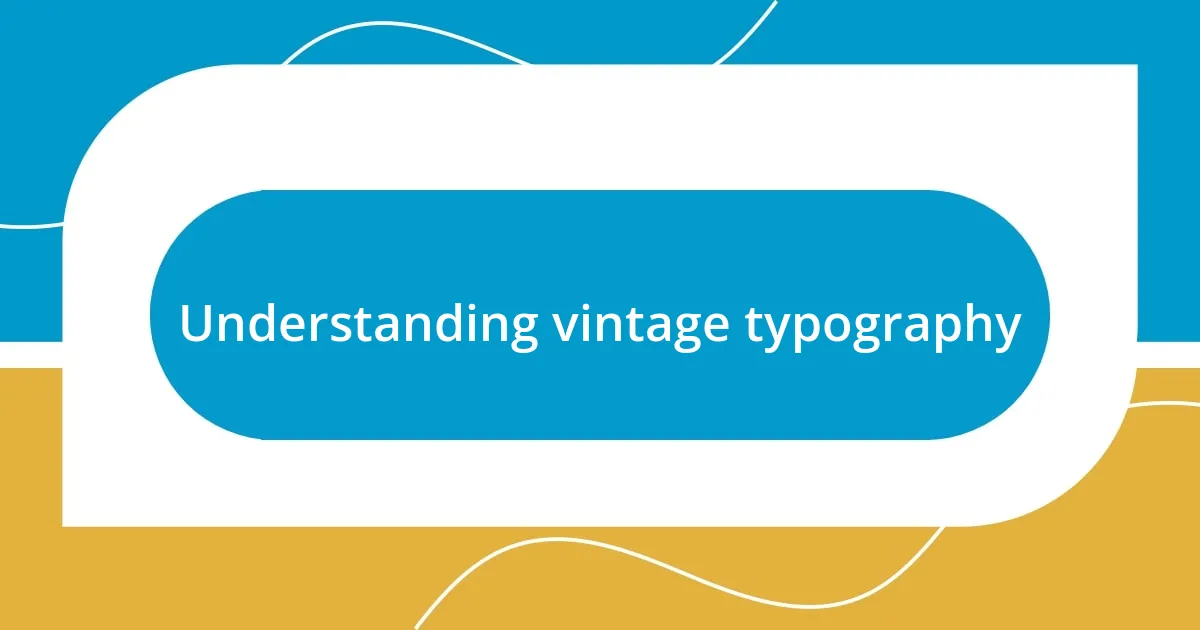
Understanding vintage typography
Vintage typography is more than just old fonts; it’s a glimpse into history. Each letter has its own story that reflects the design sensibilities of a particular era. I remember the first time I stumbled upon a vintage poster at a flea market. The typography immediately drew me in, with its elegant curves and unique flair. Have you ever felt that thrill when discovering something that feels so alive with character?
What I find fascinating is the way vintage typography captures emotions. The bold serifs of the 1920s convey a sense of grandeur and optimism, while the delicate scripts of the Victorian era evoke romance and nostalgia. It’s like stepping into a time capsule. I often think about how these choices in type reflect the designers’ intentions. How could the feeling of handwritten letters influence a brand’s identity today?
As I dive deeper into this art form, I realize that vintage typography influences modern design in subtle yet powerful ways. The revival of these classic styles offers a sense of authenticity in today’s digital age, where so much feels ephemeral. I often ask myself, how can we bring the warmth and personal touch of vintage typography into our current projects? It’s a challenge, but one that speaks to the heart of design.
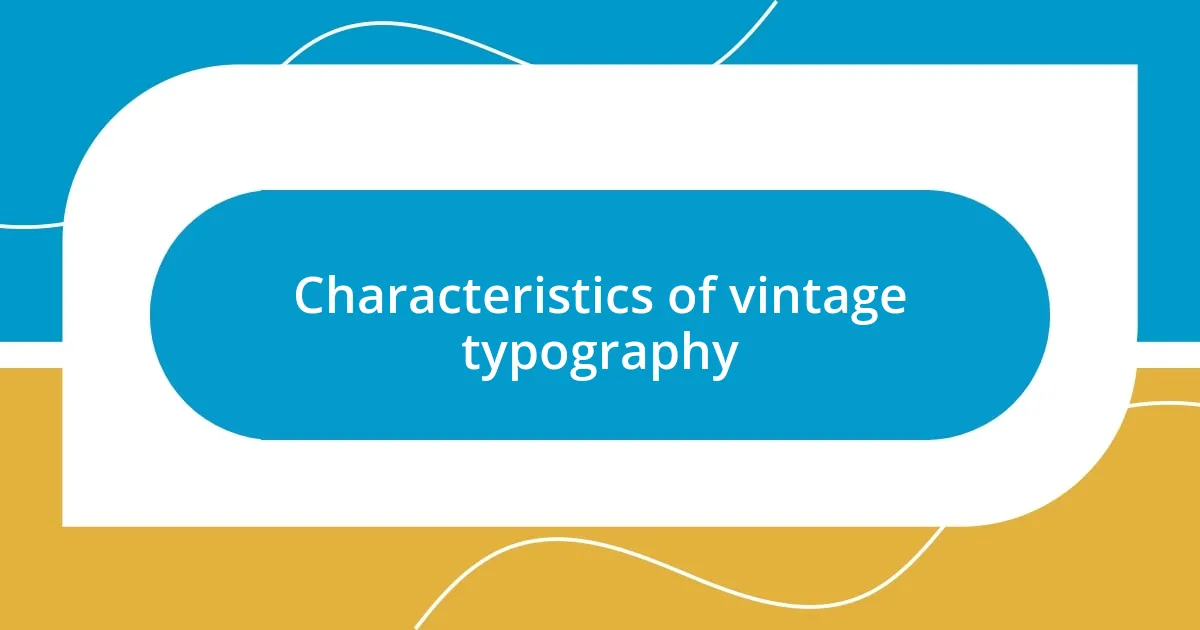
Characteristics of vintage typography
Vintage typography stands out due to its unique characteristics that echo the design principles of its time. I can still picture the first time I encountered an ornate typeface from the Art Nouveau period. Its flowing lines and intricate details instantly captivated me, making me appreciate how typography can serve as a storytelling medium. Each style evokes different moods and reflects cultural nuances that are deeply rooted in their respective eras.
Some key characteristics of vintage typography include:
- Serifs: These are the little lines at the ends of letters that can convey elegance or boldness, depending on their design.
- Ornamentation: Many vintage typefaces incorporate decorative flourishes, enhancing their visual appeal.
- Handcrafted Feel: A lot of vintage typography mimics the imperfections of hand-drawn letters, adding a personal touch that feels more relatable.
- Variety in Width: Vintage fonts often have varying stroke widths, giving them a dynamic quality that catches the eye.
- Nostalgic Styles: Each decade has its signature look, from Victorian elegance to 70s psychedelia, evoking specific historical sentiments.
Whenever I look at these characteristics in detail, I can’t help but feel a sense of connection to the past. It’s as if each letter has lived a life of its own, whispering stories from another time.
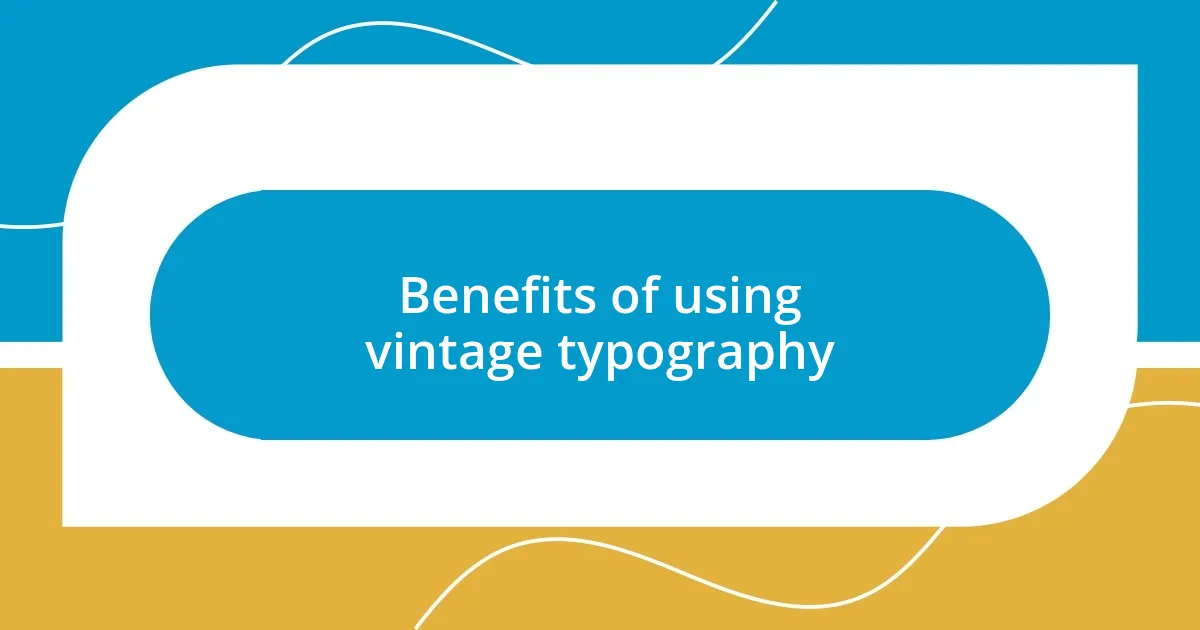
Benefits of using vintage typography
Using vintage typography can significantly enhance visual communication in various ways. One of the most notable benefits is the emotional resonance it carries. For instance, I once designed an invitation using a vintage typeface from the 1950s, and it transformed the entire feel of the event. The nostalgic script stirred a sense of warmth and connection among the guests. Isn’t it remarkable how a simple change in font can evoke such strong feelings?
Another advantage is the unique character that vintage typography brings to modern projects. In a world saturated with sleek, minimalistic designs, I find that incorporating vintage elements creates a distinct identity. I remember adding a vintage typeface to a branding project for a coffee shop, which not only drew attention but also communicated the establishment’s commitment to quality and tradition. It felt alive, adding depth and personality that modern fonts sometimes lack.
Furthermore, vintage typography often stands as a testament to craftsmanship and artistry. The meticulous details in these typefaces remind me of an era when typography was an art form rather than just a functional element. This dedication to design can forge a strong connection with an audience. I’ve noticed that people are often fascinated by these intricate designs—there’s a sense of authenticity that resonates with them in a digital world that frequently prioritizes speed over artistry.
| Benefit | Description |
|---|---|
| Emotional Resonance | Evokes feelings of nostalgia and warmth, enhancing the overall experience. |
| Unique Character | Stands out in modern design, creating a distinct identity for brands and projects. |
| Craftsmanship | Reflects artistry and attention to detail, fostering authenticity and connection. |
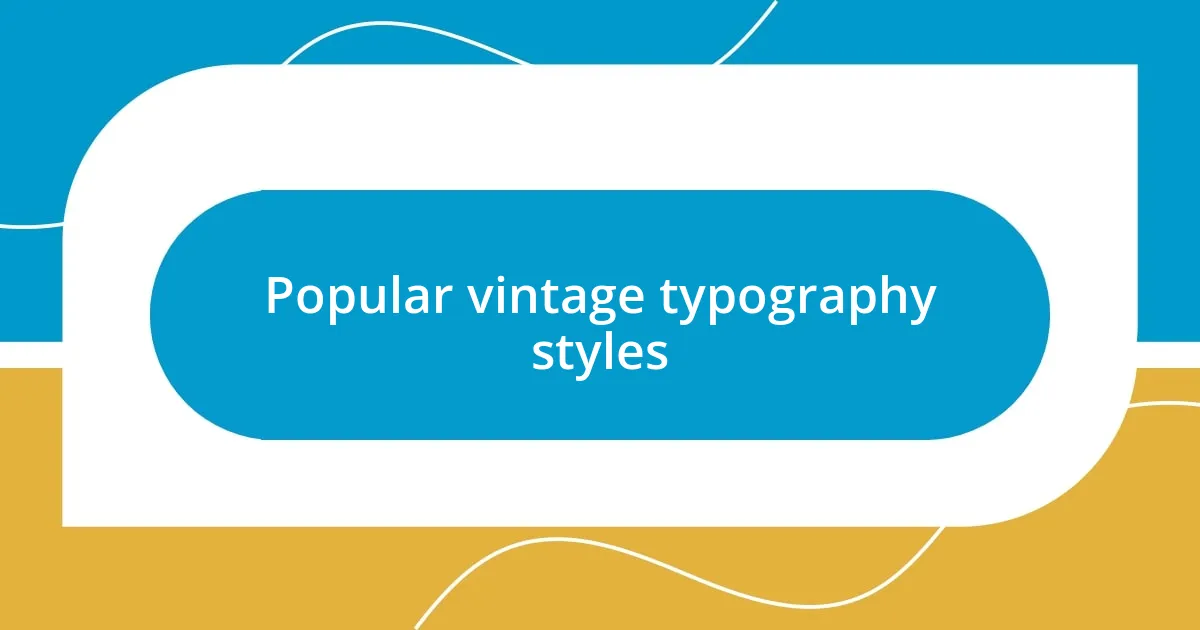
Popular vintage typography styles
When I dive into the world of vintage typography, I’m often drawn to the Gothic style, which boasts bold and dramatic letterforms. I recall a time I designed flyers for a local theater using a Gothic typeface. The dark, intricate letters perfectly captured the essence of the shows we were promoting—full of mystery and allure. Isn’t it fascinating how just one typeface can set an entirely different atmosphere?
As I explore other styles, the Art Deco era always captures my heart. The geometric shapes and streamlined elegance resonate with a sense of luxury and refinement. I once used an Art Deco typeface for a wedding invitation, and it made the entire event feel more sophisticated. It’s amazing how such a sleek style can transform anticipation into a visual feast, making you think about the elegance of the past.
Then, there’s the whimsical charm of retro script fonts, which I can’t help but adore. I remember designing a promotional poster for a local ice cream shop that featured playful, flowing letters reminiscent of the 1950s. The responses were overwhelming—people felt like they were being transported back to carefree summers, bustling soda fountains, and warm laughter. Can you see how nostalgia in typography can create such a vivid connection?
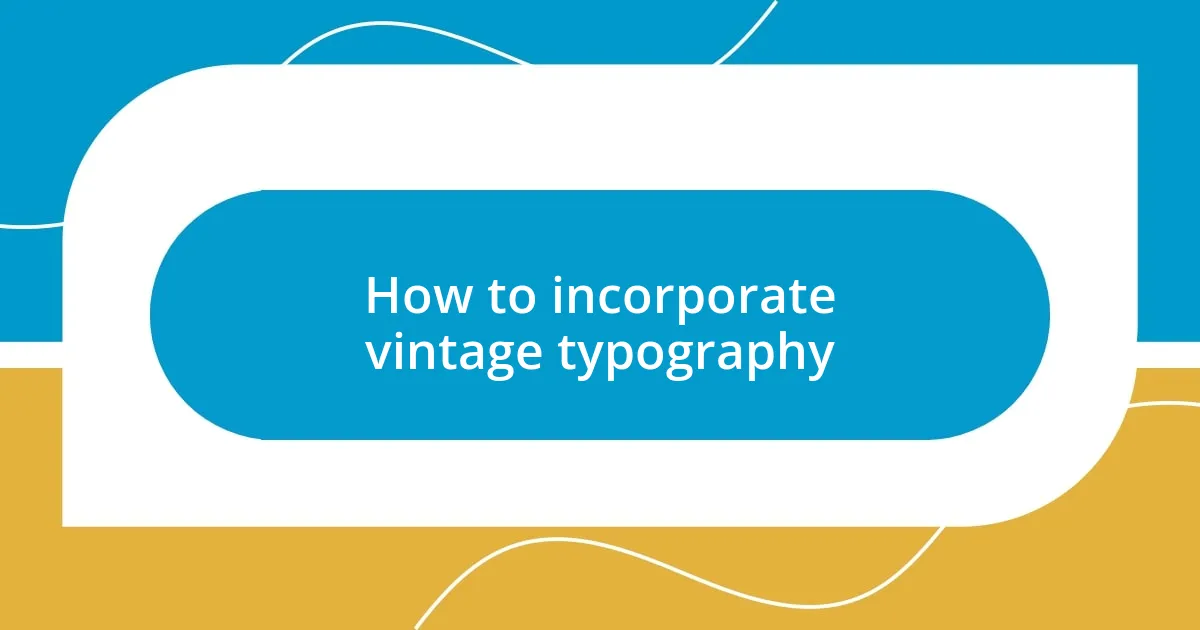
How to incorporate vintage typography
Incorporating vintage typography into your projects can be a game changer. I remember when I decided to give my personal blog a facelift. By using a vintage typeface for my headers, I instantly transported my readers to another time, adding warmth and personality to my content. It’s amazing how a different typeface can set the mood; it felt more like a conversation over coffee than just a standard read.
To seamlessly blend vintage typography with modern design, I often find layering techniques useful. For example, I once worked on a branding project where we paired a classic serif font with clean sans-serif text. This mix brought a contemporary edge while paying homage to the past. The result? A sophisticated look that felt both nostalgic and fresh. Don’t you think that striking the right balance can enhance the overall aesthetic?
Another approach I’ve enjoyed is creating contrast with color and spacing. I vividly recall designing a poster for a vintage fair where the typeface was bold and colorful against a muted background. This technique drew the eye and made the text stand out beautifully. It reinforces the idea that vintage typography doesn’t have to fade into the background; instead, it can shine brightly as a focal point. How do you feel about using color to amplify text’s impact?
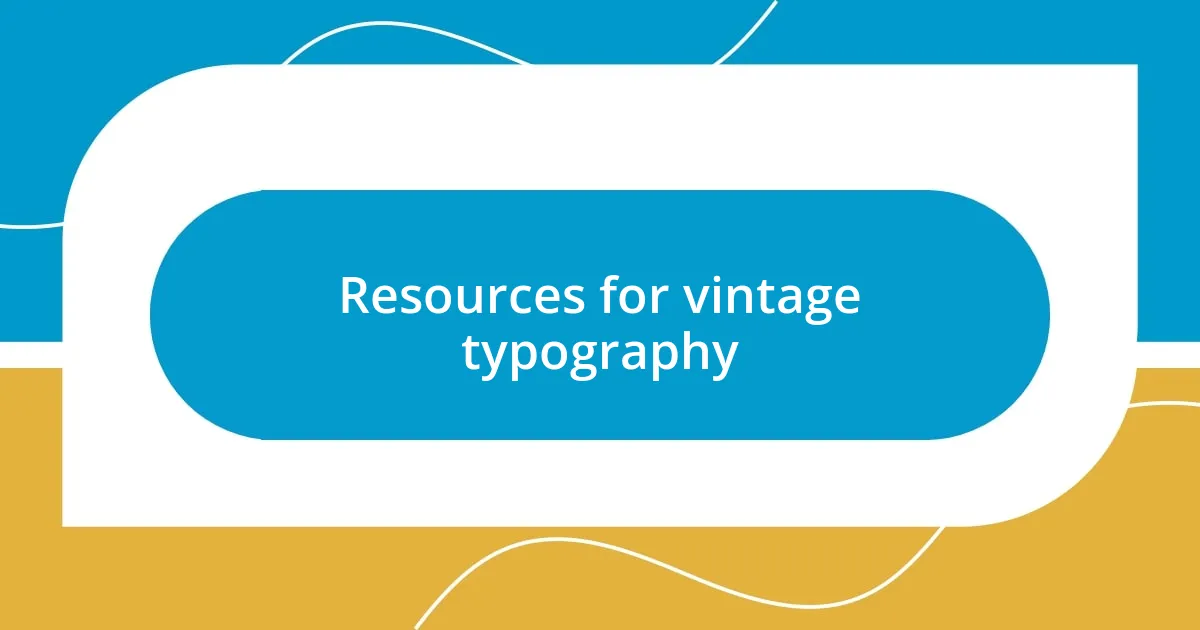
Resources for vintage typography
Resources for vintage typography abound, making it easier than ever to find inspiration and tools. I’ve found great value in websites like DaFont, where you can discover countless free vintage typefaces. It’s like wandering through a treasure trove, and I remember feeling an electric thrill when I stumbled upon a stunning Victorian script font that perfectly complemented a project I was working on. Have you ever had a moment like that, where a font just clicks?
Another fantastic resource is vintage typography books that delve into design history. One of my favorites is “Letters of Credit” by Chris Baker, which not only showcases beautiful examples but also narrates the evolution of type design. Reading through it felt like sipping a fine wine, savoring the rich flavors of typography history. I often find myself reflecting on how these stories impact our modern designs. How does the past influence your own creative journey?
Lastly, exploring social media platforms like Instagram or Pinterest has opened up a world of visual inspiration for vintage typography. I love scrolling through curated collections, and I remember spotting a beautifully designed poster that sparked a whole new idea for my next project. It’s incredible how digital resources can foster a sense of community among typophiles. Have you ever been inspired by something you found online that changed your approach?


